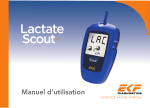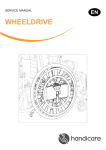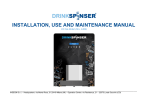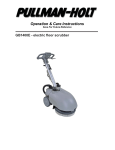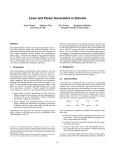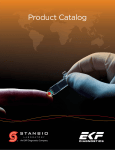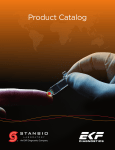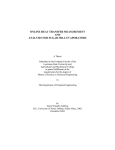Download User Manual - Lactate Scout
Transcript
Sales and Service: EKF-diagnostic GmbH Ebendorfer Chaussee 3 39179 Barleben Phone: +49 (0) 39203-785-0 Fax: +49 (0) 39203-785-24 www.ekfdiagnostics.com [email protected] Manufacturer: SensLab GmbH An EKF Diagnostics Company Bautzner Str. 67 04347 Leipzig Phone: +49 (0) 341-234-18-41 Fax: +49 (0) 341-234-18-40 www.senslab.de [email protected] User Manual Part number 7023-9012-2350 Rev. 2.0–11/2013 Copyright© 2013 SensLab GmbH No part of this publication may be reproduced, transmitted, transcribed, stored in any retrieval system or translated into any human or computer language by any means or in any form, without the prior written permission of Senslab GmbH. Part Number: 7023-9012-2350 Rev. 2.0 –11/2013 Lactate Scout+ User Manual Valid from serial no. XXXXX02135 Manufacturer SensLab GmbH Bautzner Str. 67 04347 Leipzig Germany Phone: (+49) 0341 - 234 18 41 Fax: (+49) 0341 - 234 18 40 www.senslab.de Sales and Support: This product has been tested to the requirements of CAN/CSA-C22.2 No. 61010-1, second edition, including Amendment 1, or a later version of the same standard incorporating the same level of testing requirements. 2 EKF-diagnostic GmbH Ebendorfer Chaussee 3 D-39179 Barleben Germany Service: +49 (0) 39 203 78514 Email: [email protected] www.ekfdiagnostics.com Intended use and safety guidelines • The Lactate Scout+ may only be used with the Lactate Scout sensors to determine the lactate concentration in capillary whole blood. The Lactate Scout sensors are only for single use. • O nly for external application outside the body. (In-vitro diagnostic application) • L actate Scout+ is suitable for self-testing. It can also be used by qualified staff in various medical faculties. Test results should only be used as guidance in making decisions for further treatment of patients following a suitable period of evaluation. • K eep Lactate Scout+ and accessories out of the reach of children (choking hazard due to small parts). • T he principal risk of infection is in the handling of blood samples when measuring lactate concentrations. 3 • Only undamaged and unused lancets and sensors may be used. Used sensors, lancets and cellulose cloths pose a risk of infection. These must be safely disposed of as household waste following use. • P rotective gloves must be worn when performing tests on third parties. • T he sterile single use lancets may only be used to draw capillary blood on the fingertips or earlobes. Unpacking Unpack the system and check that the following components are present and undamaged in the pack. If there is anything missing contact customer support. Lactate Scout+ Analyzer / 1,5V AAA/LR03 batteries (2x) User manual READ INSTRUCTIONS PRIOR TO USE Only use the device for the purpose described in this manual. Do not use any other accessories than those supplied by the manufacturer. Do not use the device in case of malfunction or damage. In case of non-intended use the safety measures for the device may become ineffective. KEEP INSTRUCTIONS FOR USE Not conforming to cautions may lead to serious health damage. Not conforming to information marked with “attention” may cause faulty measurements or damage of the device. Contents 1. Getting started Lactate Scout+ analyzer and sensors 6 Inserting the batteries 7 Code setting.8 Temperature sensor 9 Care and cleaning, Disposal 10 4 2. Taking a measurement Inserting a sensor Blood sampling 12 14 3. Performing step tests Settings for step tests 16 Afterload timer 18 Timing functions for step tests 18 Test results .19 Turning the device off 19 Deactivate the step test mode 19 4. Settings Selecting and modifying settings 20 5. Data storage Transferring data to the PC 23 6. Troubleshooting Functionality check in dSC mode Error description, potential causes and solutions 26 28 7. Technical specifications Parameters .32 Explanation of symbols 33 8. Accessories 5 Purchasing accessories 34 Getting started Lactate Scout+ analyzer · Insertion slot (1) for the sensor · Display window (2) for the display of test readiness, the blood lactate concentration, warnings and setting options · Scroll wheel (3) for easy operation of the analyser. Scroll up and down to view menu options. Press the wheel to access the menu Scrolling: Select option or search 1 2 3 Pressing: Activate/confirm selection or deactivate/cancel selection Turn on or off by pressing for 2 seconds Lactate Scout+ sensor · Measurement chamber (4) with opening for the collection of the blood sample · Connecting contacts (5) must be inserted completely into the insertion slot of the measuring device with the black contact surface facing up 6 4 5 Inserting the batteries Batteries are included with your Lactate Scout+. Two LR03 / AAA (1.5 V) batteries must be inserted prior to the initial use of your Lactate Scout+. Alkaline or zinc carbon batteries can be used. Only use batteries of the same type. If the time to replace the batteries exceeds one minute, the date and time setting will be lost and must be re-entered (see page 20). The stored data and settings will be kept, however. The Lactate Scout+ must be turned off to replace the batteries. Gently, push the battery cover outward. Remove the used batteries. When inserting the new batteries, ensure that the polarity is correct (+/-). The batteries must be inserted in the same direction. Push the battery cover back until it snaps into place. Attention: In the case of prolonged periods of non-use and when flying, the batteries must be removed. 7 Please note: Used batteries must not be disposed of with household waste. Return them to the shop or any public collection point. Getting started Code setting The first time the Lactate Scout+ is used, a two-digit code must be set. This code is printed on the label of the sensor vial. · Turn on the Lactate Scout+ device by pressing the scroll wheel for two seconds. The request to set the code appears on the display (blinking) “set CODE” (1). · After pressing the scroll wheel again briefly, the code setting menu is activated and the left code number will blink (2). Next, set the left digit listed under “code” on the sensor container by scrolling up or down and finally confirm by briefly pressing the scroll wheel. · To enter the right code digit, which will now be blinking (3), repeat this process. The device is now coded (4). The finalisation of coding is confirmed by a signal tone. To complete the process, insert a sensor or turn off the device. 8 Attention: Prior to using a new or other sensor container, it is necessary to always check whether the code on the label corresponds to the current code in the device. If necessary, the latter must be reset. 1 2 3 4 Temperature sensor In order to be able to achieve equally reliable test values under different climatic conditions, the Lactate Scout+ is equipped with a temperature sensor. It is located underneath the insertion slot for the sensors. The functionality of the temperature sensor impacts the establishment of test readiness as well as the achieved test values. Therefore, contamination must be avoided. To ascertain the ambient temperature, ensure that the temperature sensor is not touched by hand or covered. The ambient temperature of the device can be displayed for 2 seconds by pressing the scroll wheel briefly in test mode. 9 Attention: Ensure that the measuring device and sensors do not vary considerably from each other in temperature prior to a test (e.g. for winter sports or after storing the sensors in the refrigerator). If necessary, allow sufficient time for the temperature of the sensors and the measuring device to adjust. Getting started Care and cleaning The Lactate Scout+ measuring device is an electronic precision measuring device and must be handled and stored with care. It must be protected from liquids, moisture, prolonged solar radiation and excessive effects of cold and heat (below 0°C and above +50°C). Heavy mechanical loads, improper handling and contamination can partially or completely restrict functionality. Ensure that no liquid or dirt enters the inside of the device through the openings (insertion slot for sensor, scroll wheel and battery housing). If blood, test solution, dust or other contaminants are present on the housing, it must be cleaned using a soft, lint-free towel or cellulose cloth (e.g. paper towel), which has been pre-soaked in a mild cleaning agent (e.g. water with a minimal amount of washingup liquid), and then wiped dry. Medical staff should adhere to the regulations of the medical facility in this case. 10 Never insert foreign objects or sensors other than Lactate Scout sensors into the insertion slot. Disposal In the case of blood lactate measurements it is impossible to exclude the possibility that the device will come into contact with blood. As a result, there is a risk of infection. Dispose of the device with household waste after removing the batteries. (The device does not fall under the application of the European Directive 2002/96/EC regarding electrical and electronic equipment). Attention: If the device housing is opened by the user, this will invalidate all warranty and liability claims. Disinfecting agents containing isopropanol will result in the permanent tarnishing of the display window. 11 Taking a measurement Inserting a sensor Remove a sensor from the dessicant vial. The sensor must be inserted into the insertion slot of the device with the black connection contact surfaces facing up (see right) (1). Regardless of whether the device was on or off before, the test mode is automatically started upon inserting the sensor. After a brief (one second) display of the code, a blinking drop appears on the display indicating that the device is ready to test (2). 1 2 12 Attention: Store the sensors only in the original container and within the specified temperature range of -18°C to +8°C. Only remove the sensors for the purpose of testing. Close the container again immediately. Never leave open! Protect against solar radiation, prolonged temperatures above 25°C and moisture. Temperatures outside the specified range during transportation and storage may influence the function of the sensors and lead to faulty results. 13 Sensors, once removed from the container, must be used immediately. The sensors must be kept at room temperature with the measuring device at least 20 minutes (at least two hours when stored in the freezer) in the closed container prior to testing. The expiration date of the sensors on the label of the sensor container must be observed. Following the initial opening of the container, the sensors must be used within 90 days. Taking a measurement Blood sampling and analysis Produce a drop of blood with a sterile single use lancet approved for capillary blood sampling. Follow the instructions for use of the lancet. The site where blood is drawn must be clean and free of sweat. Lactate accumulates on the skin from perspiration and leads to falsely elevated results. Hands (or earlobes) must be disinfected and washed with fresh, hygenically-safe water. Dry hands thoroughly prior to testing. Avoid pressing on the puncture site too extensively as there is a risk that sweat and/or tissue fluid can merge with the blood droplet and falsify the test result. The drop of blood must not run. Bring the fingertip with the droplet of blood close to the tip of the sensor that has been inserted in the device so that the blood can be absorbed (3). Once the measurement chamber of the sensor is completely filled, an acoustic confirmation signal sounds and the test procedure will be activated. “LAC” and a 14 circular symbol with a progress bar appear on the display as well as the assigned memory space number (4). After ten seconds, a second acoustic signal sounds and the test result is displayed in the measurement unit “mmol/L” (5). This is stored automatically along with the date and time of the test. Attention: There is a risk of erroneous (segmented or insuffiecient) filling of the measurment chamber of the sensor. This may occur if the subject or user is moving when a sample is taken. To avoid this, ensure that the tip of the sensor remains in contact with the drop of blood whilst the measuring chamber is filling. Caution: The safety lancet is intended for single use and must be disposed together with the used sensor (household waste). 4 3 15 5 Performing step tests Settings for step tests Lactate Scout+ allows for the recording of values for step tests. The general procedure for preparation, sampling and measurement is the same as the individual test (see pages 12 - 15). After inserting a sensor and confirmation of test readiness (blinking drop) select the appropriate step test phase for the subject. The step test phases are displayed as follows: 1. PL: Preload (for resting values) 2. LOAD: Load (for load values) 3. AFL: Afterload (for afterload values) 1 2 3 4 It is possible to begin with any of the step test phases, however it is not possible to change later. (e.g. a preload cannot be selected after the load). 16 The number of the lactate concentrations recorded per step test phase correlates to the number of conducted tests. The count of tested values occurs separately for every step test phase and is automatically displayed on the screen to the right of the respective step test phase symbol (4). One test is intended for every load step of the step test phase (“LOAD”). 5 6 7 8 Upon inserting a new sensor, the last selected step test phase is preset and is displayed together with the next digit for the continued test. Now you can perform this test or change by scrolling up to the following phases or exit the step test mode. To exit the step test mode, turn the scroll wheel directly following the test while the sensor (5) is still inserted until “End” (6) appears on the display. Confirm by pressing the scroll wheel. Exiting is also possible prior to a new test. In this case, after achieving test readiness (7), scroll to “End” (8) and briefly press the wheel. The Lactate Scout+ is now in the 17 individual test mode once again (blinking drop). Attention: One hour after the last step test measurement, the measuring device automatically returns to the individual test mode. Performing step tests Afterload timer If you select the test mode “AFL” for an afterload test, the time in minutes and seconds elapsed from the last measurement in the step test phase “LOAD” will appear below on the display instead of the time. In addition, a brief signal tone sounds after every minute that passes. After no more than twenty minutes, the timer on the display will remain at “20:00” and will only be reset upon restarting a step test. The afterload timer will only be activated if one or more load tests were performed. Timing functions for step tests Using the Countdown function “COUNT DOWN” preceded by the step duration “DUR”, it is possible to set times of up to 10 minutes and to set a signal as they elapse (page 20). 2:56 To be able to control and adjust the load intensity and step length for field tests more efficiently, the Lactate Scout+ offers supplemental application possibilities in the setting mode (see chapter 4). With the stop clock “CLOCK”, you can monitor your lap time (maximum of ten minutes per load step), see page 20. 18 Display of the expired time following the last load measurement via the afterload timer Detailed information on how to perform step tests can be found in the Lactate Scout+ Compendium on the Lactate Scout Info CD or on the website www.lactatescout.com Test results Test results that are in “idle mode” i.e. measured prior to exercise, should be between 0.5 mmol/L and approx. 2.5 mmol/L. The resting values depend considerably on the physiological condition of the subject as well as the previous nutritional intake. In some cases, the value can be increased due to illness. After exercise, the lactate value can be more than 20 mmol/L, particularly in those engaged in intensive professional sports depending on the duration and intensity. Turning the device off The device is turned off in the test mode by removing the sensor. Otherwise, the Lactate Scout+ will turn off automatically after five minutes. 19 Deactivate the step test mode In order to prevent accidental switching into the step test mode or if step test measurements should always be recorded as single measurements the step test function can be deactivated using the Lactate Scout Assistant Software Ver. 1.0.6. The setting can be re-activated in the same way. For detailed instructions see Lactate Scout Assistant Software manual. Settings Selecting and modifying settings Settings are made in the "Settings and storage mode“. The settings are only accessible when no sensor is inserted. Press scroll wheel for two seconds until a signal sounds and the display with all elements and symbols appears. Upon release the first submenu “set CODE” symbol is shown. Move between submenus by scrolling the wheel. Accessibility of the submenu is indicated by blinking. Briefly press the scroll wheel to activate a submenu. Scroll to perform the desired settings in the submenu. Press scroll wheel briefly to confirm the setting. Exit the settings menu by pressing the scroll wheel for two seconds. (set CODE): enter the correct Code for the sensors in use, for detailed description see page 8. (set) (DUR): at selection of this submenu the current step duration appears. Set desired step duration using the scroll wheel as described above. Maximal duration of one step is 10 20 minutes. Minimal setting is 10 seconds. (COUNT DOWN): by activation of this submenu the count down for the previously selected step duration is started. A short signal tone will sound after each minute and at every second during the last 10 seconds of a step. An initially filled black circle will empty quarterly after 25%, 50%, 70% and 100% of the step duration. The elapse of the step duration is indicated by brief consecutive signal tones and blinking “0:00” (CLOCK): activation of this submenu starts the stop clock immediately. Full minutes are indicated by a brief signal tone. The displayed circle fills consecutively with one black quarter every 2,5 minutes. After 10 minutes the device switches back to the “CLOCK” menu. The stop clock can be stopped during the 10 min interval by briefly pressing the scroll wheel. A signal will sound and the time will be stored together with the next lactate test result. (set) (Time Date): set correct hour by turning the scroll wheel, confirm by briefly pressing the scroll wheel. Repeat consecutive for minute, day and year. Format: hh:mm and dd/mm/yy Exit settings mode Press for 2 s Enter settings mode Press for 2 s Scroll wheel 21 Settings (set) : settings for data transfer, see instructions page 23-25. (set) : the speaker volume can be selected using the scroll wheel as described above. The signal intensity is indicated by the speaker symbol being full with three hemispheres (loud), full with one hemisphere (medium) or empty (muted) (set) (CTRL D+S): settings for performing a functionality test, see instructions page 26-27 (mem): to view stored test results the memory submenu must be activated. The last result is displayed together with the storage position number and if available with the step test data achieved during the test. The storage position number is showed intermittent with the date and time of the test result. The memory can hold up to 250 test results. If more values are recorded the oldest value will be overwritten first. 22 Data storage Transferring data to the PC The Lactate Scout+ is capable of the wireless transfer of data to a PC using “BluetoothTM”. The data transfer menu is activated in the setting and storage mode. Press the scroll wheel for two seconds and scroll until “set” and a BluetoothTM symbol “ ” appears blinking on the display (1). The menu is activated by briefly pressing the scroll wheel so that “OFF” and the continually blinking BluetoothTM symbol below are displayed on the main display (2). 23 1 Menu for activating the Bluetooth™ connection 2 Bluetooth™ is inactive Data Datastorage storage By turning the scroll wheel by one position, the BluetoothTM module is connected, “On” appears on the main display and the BluetoothTM symbol is surrounded by a black line (3). After confirmation (briefly press the scroll wheel), the BluetoothTM module in the device is activated. The Lactate Scout+ bluetooth function, can be used with Windows XP, Windows Vista, Windows 7 and Windows 8. For data transfer to a PC additional software must be installed on the PC. A generic data export tool Lactate Scout Data link is availabe as free download from the website www.lactatescout. com". Advanced software solutions like the Lactate Scout Assistant software including data management and chart functions for performance analysis are available for purchase from EKF Diagnostics. The activated BluetoothTM module is permanently displayed in the setting and storage mode as an outlined BluetoothTM symbol (4). 24 3 4 Bluetooth™ is active Display of Bluetooth™ symbol after activation Attention: A detailled description for the initial setup of the Bluetooth TM connection is available on the website www.lactatescout. com. Please use the Bluetooth™ dongle recommended by us. In addition to the possibility of transferring in the setting and storage mode, a data transfer is also possible in the test mode with an activated BluetoothTM module. Following the test, the BluetoothTM module is turned on while the test values are displayed (5, 6) in order to enable a transfer of data, e.g. the last tested values. (The success of this option depends, however, on the PC software used for presenting the tested data.) The procedure for turning off the active BluetoothTM function is consistent with the procedure for turning it on as described on page 24. 5 6 Display during a test with an active Bluetooth™ module Display after a test with an active Bluetooth™ module Attention: To decrease energy consumption, the Bluetooth™ module should not be activated permanently, but rather only for the purpose of transferring data. The reach of the Bluetooth™ connection is no more than 10 metres without spatial barriers. The functionality of the device can be influenced by strong electromagnetic fields (e.g. in the proximity of radio towers). 25 Troubleshooting Functionality check in dSC mode A functionality check should be performed if there are any doubts regarding the accuracy of the test result or the correct function of the device or sensors.Test solutions are available in following concentrations: 10 mmol/L, 5 mmol/L and 2 mmol/L. Activate the submenu Ctrl D+S as described under settings. In the display the letters "dSC" are shown blinking. Insert sensor. The code display appears briefly and switches to the blinking drop symbol indicating that the device is ready to test. At the same time the target value is displayed with the measurement unit (mmol/L). All test solutions must be stored at 5°C to 25°C. The expiry date for the test solution is stated on the label of the test solution bottle. After initial use the test solution bottle must be firmly closed for further storage and must be used within 3 months. Turn the scroll wheel to select the appropriate target concentration of your test solution. Do not confirm by pressing the scroll wheel! Touch the drop of test solution with the sensor like when performing a regular measurement, see instructions page 14-15. Preparing the functionality test: Allow the test solution, the sensors and the device to adjust to ambient temperature before performing the test. The test starts and the round progress display is shown together with "dSC". An acoustic signal indicates that the test is completed. The measured lactate concentration is displayed. Open the test solution bottle and wipe off the opening. Discharge the first droplet and press out the next droplet onto a clean non-absorbent surface. 26 For test solutions of 10 mmol/L the result is evaluated by the device: “OK”: the test result is within the specified limits, see label of the test solution bottles. If the test result is outside the specified range a plug connector test is started automatically and an error message “Er3” or “Er4” is displayed (see error messages). Test solutions can only be measured in dSC mode. Any measurement of test solution in the regular test mode will give wrong results. 27 Attention: Never hold the opening of the test solution bottle directly up to the sensor as its contents will become contaminated and unusable. Caution: Ingesting or contact of test solution with the mucous membranes must be avoided. Keep the test solution away from childrenchoking hazard! Troubleshooting Error description, potential causes and solutions 28 Error Description and potential cause Solution Er1 Sensor error Faulty sensor due to damage, incorrect storage or sample uptake prior to test readiness Use a new sensor from a correctly stored container Er2 Error when filling the sensor Blood droplet too small or ran, contact time sensor to blood droplet too short, interrupted sample absorption or sensor pressed against skin Repeat the test with a new sensor. If necessary promote circulation (gently massage the puncture site) Er3 Plug connector error There is a problem with the contacts of the lactate sensor Repeat the functionality test with a new sensor. If the error continues to appear please contact Lactate Scout+ Service. Er4 Functionality test not successful Repeat the functionality test using new materials and new coding, follow the instructions for performing the test carefully, ensure correct selection of test solution level. If the error continues to appear please contact Lactate Scout+ Service. 29 Er5 (+blinking temperatur symbol) Temperature error The temperature is outside the operating range. Ensure that the ambient temperature is within the specification of the device. Er6 Electronic error inside the device Turn the device off and restart. If the error continues to appear please contact Lactate Scout+ Service. Error when transferring data Too large distance between Bluetooth module and PC or obstacles in the way, disturbance of signal by strong elektromagnetic fields (e. g. caused by electronic devices or transmitter masts), software error Limit the distance, avoid obstacles or interfering transmitters, reinstall software Troubleshooting Date bar Blinking date/time bar on the display The date/time settings are lost. Set date and time Battery symbol, blinking Battery error The batteries are nearly empty. Replace batteries bat Battery error The batteries are empty or expired or low quality batteries have led to corrosion of the battery contacts. Replace batteries. Use only quality batteries. Contact Lactate Scout+ Service in case of corroded battery contacts. Code control The display “set CODE” blinks after inserting a sensor The set code must be checked and and if necessary corrected after 24 tests. LO display Test result too low The test value is below the test range of the Lactate Scout+ Repeat the test using new sensor and new coding, follow the instructions for performing the test carefully, dry hands carefully prior to testing. Perform functionality test. In case of Er4 message contact Lactate Scout+ Service. HI display Test result too high The test value is above the test range of the Lactate Scout+ Repeat the test using new sensor and new coding, follow the instructions for performing the test carefully, wash hands carefully prior to testing. Perform functionality test. In case of Er4 message contact Lactate Scout+ Service. 30 Turn on Device fails to turn on Replace batteries. Press scroll wheel > 2 seconds. If the problem persists please contact LactateScout+ Service. No test readiness No drop symbol displayed Sensor not inserted properly Insert sensor until it is noticeable in place with the black contact surface facing up. Signal tones No acustic signal Volume was muted in the volume setting menu Select and activate the volume under settings Display Display shut off Happens automatically after 5 minutes of inactivity Poor display contrast Too low ambient temperature or empty batteries Display elements missing Defective electronics or mechanical damage Restart the device Values appear to high/too low Repeat the test using new sensor and new coding, follow the instructions for performing the test carefully. Perform functionality test. In case of Er4 message contact Lactate Scout+ Service. Test values 31 Ensure ambient temperature in operating range, replace batteries Please contact Lactate Scout+ Service Technical specification 32 Parameter Specification Type of device Lactate Scout+ handheld device for measuring blood lactate (model from SN 0000101115) Sample material Fresh capillary whole blood Sample volume 0.2 μl Measurement range 0.5 mmol/L – 25.0 mmol/L Precision ± 3 % (minimal standard deviation: ± 0.2 mmol/L) for Hct range 35 – 50% ± 4 % (minimal standard deviation: ± 0.3 mmol/L) for extended Hct range Measurement principle Enzymatic amperometric determination of lactate using lactate oxidase Test duration 10 seconds Measurement temperature range +5 °C - +45 °C Humidity 10 - 85% relative humidity (up to 2 minutes for sensors) Storage temperature -18°C - +8°C (sensors in container) or -20°C - +50°C (device) Hematocrit range (Hct) 20 – 70 % Max. elevation for use up to 4,000 metres Data storage 250 test values with date, time and step test allocations Data transfer Integrated Bluetooth® module (Class II module BT 1.2.) Power supply 2 x 1.5 V AAA / LR03 batteries Battery life At least 1000 tests Device dimensions 91 mm (L) x 55 mm (B) x 22 mm (H) Device weight 80 g (with batteries) Explanation of symbols Symbols on containers and device labels, on instructions included in the packaging and in the operating instructions Symbol Meaning In-vitro diagnostic Product meets the requirements of the Directive regarding in-vitro diagnostics 98/79/EC Manufacturer Follow the operating instructions, read the package information leaflet Intended only for single use Expiration date Batch designation Storage temperature range Wireless data transfer with Bluetooth® module Do not expose to direct solar radiation Hazardous waste, do not dispose of in household waste Direct current 33 Accessories Purchasing accessories The following accessories are available at EKF diagnostic GmbH or at specialist retailers, as listed on the product website www.lactatescout.com. Item Item no. BigPack 72+: 3 x 24 Lactate Scout+ sensors in sensor containers 7023-3405-0846 BigPack 48+: 2 x 24 Lactate Scout+ sensors in sensor containers 7023-3405-0727 BigPack 24+: 24 Lactate Scout+ sensors in sensor container 7023-3405-1008 Lactate Scout Test Solution 2 mmol/L: Set of 5 x 2.5 ml bottles with 1.8 – 2.2 mmol/L lactate, 7023-6151-0257 Lactate Scout Test Solution 5 mmol/L + 10 mmol/L: Combi-pack of 2.5 ml bottles (2 x 5 units) with 4.5 – 5.6 mmol/L and 8.9 – 11.1 mmol/L lactate, 7023-6151-0235 Lactate Scout Test Solution 10 mmol/L: Set of 10 x 2.5 ml bottles with 8.9 – 11.1 mmol/L 7023-6141-0246 SurgiLance Safety Lancets grey, G23 7202-4306-0276 Additional product information, literature and references can be found online at www.lactatescout.com 34



































